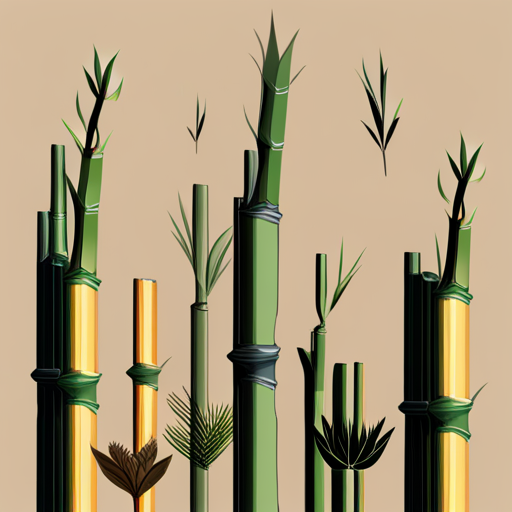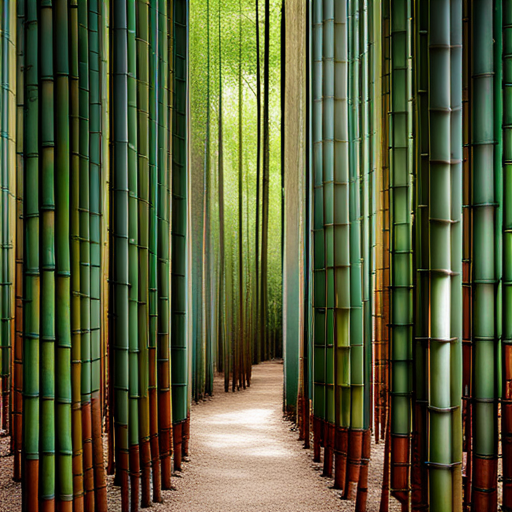Bamboo, renowned for its remarkable growth rate, is recognized as the fastest-growing plant on Earth. With certain species capable of reaching up to four feet in just one day, it is no wonder that bamboo holds the world record for the most rapid growth.
Dendrocalamus giganteus, in particular, can achieve an astounding growth of 1.3 meters within a mere 24-hour period. This extraordinary plant encompasses various types, including timber bamboo, running bamboo, and clumping bamboo. Timber bamboo can soar to towering heights of up to 60 feet, frequently employed in construction. Running bamboo spreads rapidly, extending up to 10 feet during a single growing season. Clumping bamboo, on the other hand, grows in dense clusters, rendering it ideal for containment.
Moreover, bamboo serves as a highly sustainable resource, flourishing swiftly without the need for pesticides or chemicals. Its versatility extends to numerous applications, such as construction, furniture, paper, and textiles. Bamboo’s strength-to-weight ratio surpasses that of wood, making it a superior alternative.
To ensure bamboo’s well-being, regular watering, monthly fertilization, pruning if necessary, mulching around the base, and protection from cold weather are recommended.
Contents
Our Highlighted Points
- Bamboo is the fastest-growing plant on Earth, capable of growing up to 4 feet in a single day.
- Different types of bamboo include timber bamboo, running bamboo, and clumping bamboo, each with their own unique growth habits and uses.
- Bamboo is a highly sustainable resource that grows rapidly and doesn’t require pesticides or chemicals.
– Bamboo can be used for construction, furniture, paper, and textiles, making it a versatile and eco-friendly material choice.
Growth Rate

The growth rate of bamboo is notable, with some species capable of growing up to 4 feet in a single day, making it the fastest-growing plant on Earth. Several factors contribute to the rapid growth of bamboo.
Firstly, bamboo growth is influenced by various factors such as temperature, soil conditions, and sunlight exposure. Optimal temperature ranges between 20 to 30 degrees Celsius, while excessive cold or heat can hinder growth.
Additionally, bamboo requires well-drained soil with a good nutrient content for optimal growth. Adequate sunlight is also essential, as it promotes photosynthesis and provides energy for growth. Other factors affecting growth rate include water availability, humidity, and the bamboo species itself.
In conclusion, the growth rate of bamboo is influenced by various factors, and understanding these factors is crucial for successful cultivation and utilization of this fast-growing plant.
Different Types

There are distinct categories of bamboo, including timber, running, and clumping, each with unique growth characteristics. Timber bamboo can grow up to 60 feet tall and is commonly used for construction purposes. Running bamboo has a rapid growth pattern, spreading quickly up to 10 feet in a single growing season. This type of bamboo can be invasive and may require containment measures. On the other hand, clumping bamboo grows in tight clusters, making it easier to control and maintain.
In terms of its environmental impact, bamboo is considered a highly sustainable resource due to its rapid growth and minimal need for pesticides or chemicals. It also has a positive effect on soil erosion control and carbon sequestration. The following table illustrates the growth patterns and environmental impact of the different types of bamboo:
| Bamboo Type | Growth Pattern | Environmental Impact |
|---|---|---|
| Timber | Tall and upright | Used for construction purposes |
| Running | Spreads quickly | Can be invasive, may require containment |
| Clumping | Grows in clusters | Easier to control and maintain |
Uses and Applications

One of the versatile and sustainable resources with rapid growth is bamboo, which finds applications in various industries such as construction, furniture, paper, and textiles.
- Bamboo cultivation techniques:
– Bamboo can be easily cultivated due to its fast growth rate and adaptability to different climates.
– It requires minimal water and does not require the use of pesticides or chemicals.
– Bamboo can be harvested within 3-5 years, making it a highly sustainable option for various industries.
- Benefits of using bamboo products:
– Bamboo is known for its strength and durability, making it an excellent choice for construction materials and furniture.
– Bamboo is also used in the production of paper, as it has a high cellulose content.
– Bamboo textiles are becoming increasingly popular due to their softness, breathability, and antibacterial properties.
Bamboo’s fast growth rate and versatility make it an ideal resource for various industries. Its cultivation techniques are simple, and the benefits of using bamboo products extend to construction, furniture, paper, and textiles.
Frequently Asked Questions
How long does it take for bamboo to reach its full height?
The time it takes for bamboo to reach its full height depends on various factors, including the species of bamboo and environmental conditions. Different bamboo species have different growth rates, with some reaching their full height within a few months, while others may take several years.
Can bamboo survive in cold climates?
Winter survival: strategies for cold climate bamboo cultivation include selecting cold resistant bamboo varieties, providing proper insulation, protecting from frost and wind, and mulching around the base. Adapting bamboo involves exploring the potential of cold resistant bamboo varieties.
What are some common problems or diseases that can affect bamboo growth?
Common problems and diseases that can affect bamboo growth include bamboo mites, bamboo aphids, fungal infections like powdery mildew and root rot. Solutions include regular inspection, pruning infected areas, applying organic fungicides, and providing proper drainage and airflow. Managing pests and diseases in bamboo growth is crucial for maintaining healthy bamboo plants.
How often should bamboo be watered?
Bamboo should be watered regularly to ensure proper growth. It is recommended to water bamboo deeply once or twice a week, especially during dry periods. However, the watering frequency may vary depending on factors such as climate, soil type, and bamboo species. Additionally, it is important to provide well-draining soil for optimal bamboo growth.
Are there any specific care instructions for growing bamboo indoors?
Indoor bamboo plants require bright, indirect light and should be placed near a window. They can be grown in containers with good drainage and should be watered regularly, allowing the soil to dry slightly between waterings.

